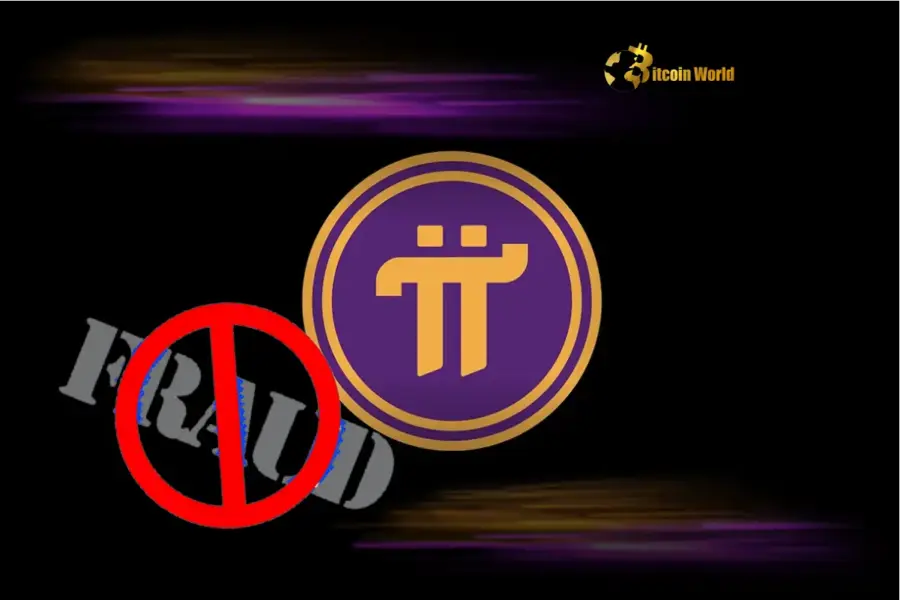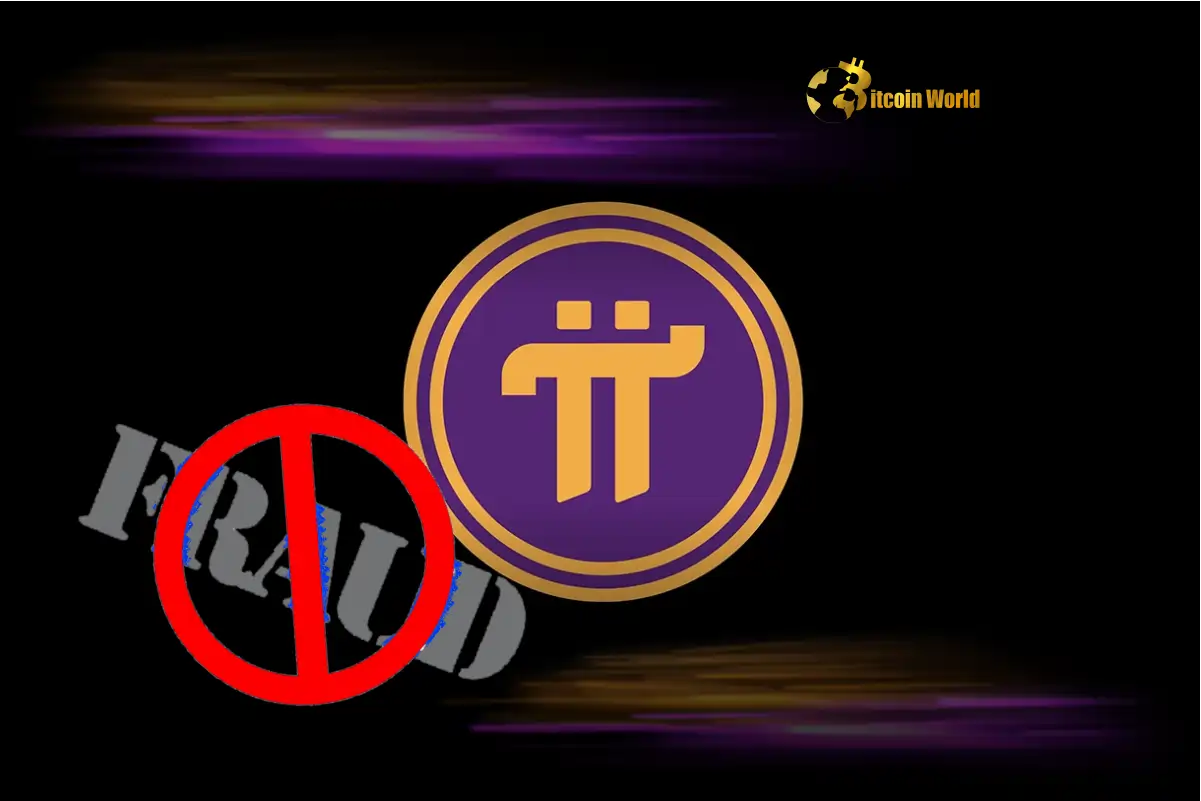Pi Network Rocked by Explosive $8B Fraud Allegations Over Massive Token Sale
0
0

BitcoinWorld

Pi Network Rocked by Explosive $8B Fraud Allegations Over Massive Token Sale
The world of cryptocurrency is no stranger to controversy and intense scrutiny, and the latest project facing serious questions is the much-discussed Pi Network. Recently, explosive allegations have surfaced, pointing towards a potential multi-billion dollar fraud linked to the project’s core team. This claim has sent ripples through the crypto community, leaving many users and observers questioning the future and legitimacy of the ambitious mobile-based crypto project.
What Sparked the Alarm? Allegations Against Pi Network
The recent wave of concern was primarily triggered by crypto investigator ‘Atlas’ on the social media platform X (formerly Twitter). Atlas published findings suggesting a significant and potentially illicit movement of PI token. The core of the allegation centers around a massive sale involving approximately 12 million PI tokens.
According to the claims reported by TokenPost, this large-scale token movement is allegedly linked directly to the Pi Network core team or individuals closely associated with them. The timing of this alleged sale is particularly concerning to the accusers, as it reportedly coincided with a notable drop in the unofficial market price of PI tokens on various platforms where it is traded (primarily as IOU or futures contracts, given Pi Network’s current enclosed mainnet status).
The eye-watering figure of $8 billion attached to this alleged sale is derived from valuing the 12 million PI tokens at a peak price observed on some of these unofficial exchanges. It’s crucial to understand that this valuation is based on speculative, non-official market prices and does not reflect a confirmed, liquid market cap for PI tokens, as the project’s mainnet remains largely inaccessible for external transfers and trading on major exchanges.
Why Are Insider Sales a Red Flag?
In the cryptocurrency space, like traditional finance, large sales of assets by project insiders are often viewed with suspicion. Here’s why:
- Lack of Confidence: It can signal that the team itself is cashing out, suggesting they may lack long-term faith in the project’s success.
- Market Manipulation: Large, coordinated sales can artificially depress the price, potentially harming smaller holders.
- Unfair Advantage: Insiders typically have more information about the project’s status and future than the general public, allowing them to profit at others’ expense.
The allegations against Pi Network suggest this scenario, raising questions about the motives behind the alleged token sale and its potential impact on the community that has been ‘mining’ PI tokens daily for years through the mobile app.
Beyond the Sale: Other Criticisms Raised by Atlas
The allegations from Atlas weren’t solely focused on the massive token movement. The investigator also reiterated existing criticisms that have long surrounded the Pi Network project:
- Over-reliance on a Multi-Level Referral System: Pi Network’s growth model heavily incentivizes users to invite new members to the network. While referral systems are common in crypto for user acquisition, critics argue Pi’s model resembles a multi-level marketing (MLM) structure, where the primary activity seems to be recruitment rather than utility or genuine blockchain activity. This structure often raises concerns about sustainability and whether the project is more focused on user acquisition numbers than actual product development or value creation.
- Low Active Wallet Numbers (Relative to User Base Claims): Despite claiming tens of millions of engaged users globally, critics point to relatively low numbers of active wallets on the actual blockchain or accessible through the Pi Browser wallet interface. This discrepancy raises questions about how many users have successfully migrated to the mainnet, completed KYC (Know Your Customer) verification, and are genuinely interacting with the blockchain ecosystem. A low number of active, usable wallets could indicate challenges in the migration process or a user base less engaged with the blockchain technology itself than with the idea of accumulating tokens for future value.
These criticisms, when combined with the serious Pi Network fraud allegations regarding the token sale, paint a concerning picture that demands a clear response from the project’s leadership.
How Did the Pi Community Respond?
Following Atlas’s claims, members of the dedicated Pi Network community quickly mobilized to counter the allegations. Their primary defense centers on the ongoing process of migrating users’ mined PI tokens from the testnet phase to the enclosed mainnet.
The community’s argument is that the large token movements observed by Atlas are not indicative of an insider sale, but rather routine transfers associated with this migration process. As users pass KYC verification, their accrued PI balance is moved from the testnet ledger to their mainnet wallet. Given the large number of users Pi claims to have, proponents argue that significant token movements are a natural part of this transition.
However, critics argue that the specific wallet addresses involved in the alleged 12 million PI token sale, as highlighted by Atlas, appear to be linked to the core team or early developers, making the ‘routine migration’ explanation for *those specific wallets* less convincing without further evidence or clarification from the Pi team.
The Silence from Pi Network’s Core Team
Perhaps one of the most significant aspects of this developing story is the lack of an official response from the Pi Network core team. As of the time of this report, the team behind Pi has not publicly addressed the serious allegations raised by Atlas or the concerns circulating within the community and broader crypto space.
In the transparent world of blockchain and cryptocurrency, timely communication from project teams is crucial, especially when faced with allegations of fraud or significant irregularities. Silence in the face of such serious claims can erode trust and fuel further speculation. The community and external observers are eagerly awaiting a detailed explanation from the Pi Network team regarding the alleged token movements and the other points of criticism.
What Does This Mean for PI Token Holders?
For the millions of individuals who have been diligently ‘mining’ PI tokens on their phones, these allegations introduce significant uncertainty. While Pi Network maintains it is building a legitimate ecosystem and preparing for an eventual ‘Open Mainnet’ phase where PI could be freely traded on exchanges, claims of insider fraud and structural issues are worrying.
It reinforces the importance of conducting thorough research (DYOR – Do Your Own Research) on any crypto project, especially those that have not yet fully launched on open markets. Users should look for transparency, clear communication, demonstrable technological progress, and a viable economic model beyond just user acquisition.
Navigating the Crypto Landscape: Due Diligence is Key
The situation with Pi Network serves as a potent reminder of the risks inherent in the cryptocurrency market. While opportunities abound, so do potential pitfalls and scams. Projects that operate in a relatively closed or opaque manner for extended periods warrant extra scrutiny.
When evaluating projects, consider:
- Team Transparency: Are the core developers known? Do they communicate openly?
- Technology & Roadmap: Is there a clear, achievable plan? Is the underlying technology sound?
- Utility: Does the token or network have a real-world use case or ecosystem being built?
- Funding & Token Distribution: How were tokens created and distributed? Are there mechanisms to prevent insider dumps?
- Community Sentiment & Criticism: Listen to both proponents and critics. Understand the potential downsides.
Conclusion: Awaiting Clarity on the Pi Network Fraud Claims
The allegations of an $8 billion insider token sale and broader criticisms surrounding its model have placed Pi Network under a harsh spotlight. While the community offers an alternative explanation, the silence from the core team is deafening and does little to alleviate concerns.
Until the Pi Network team provides a transparent and verifiable account of the alleged token movements and addresses the structural criticisms, the cloud of potential fraud will likely hang over the project. For current and prospective users, exercising caution and seeking clear information directly from official, verifiable sources is paramount. The crypto community will be watching closely for Pi Network’s response to these serious allegations.
To learn more about the latest crypto market trends, explore our article on key developments shaping Bitcoin and Ethereum price action.
This post Pi Network Rocked by Explosive $8B Fraud Allegations Over Massive Token Sale first appeared on BitcoinWorld and is written by Editorial Team
0
0
 Manage all your crypto, NFT and DeFi from one place
Manage all your crypto, NFT and DeFi from one placeSecurely connect the portfolio you’re using to start.






